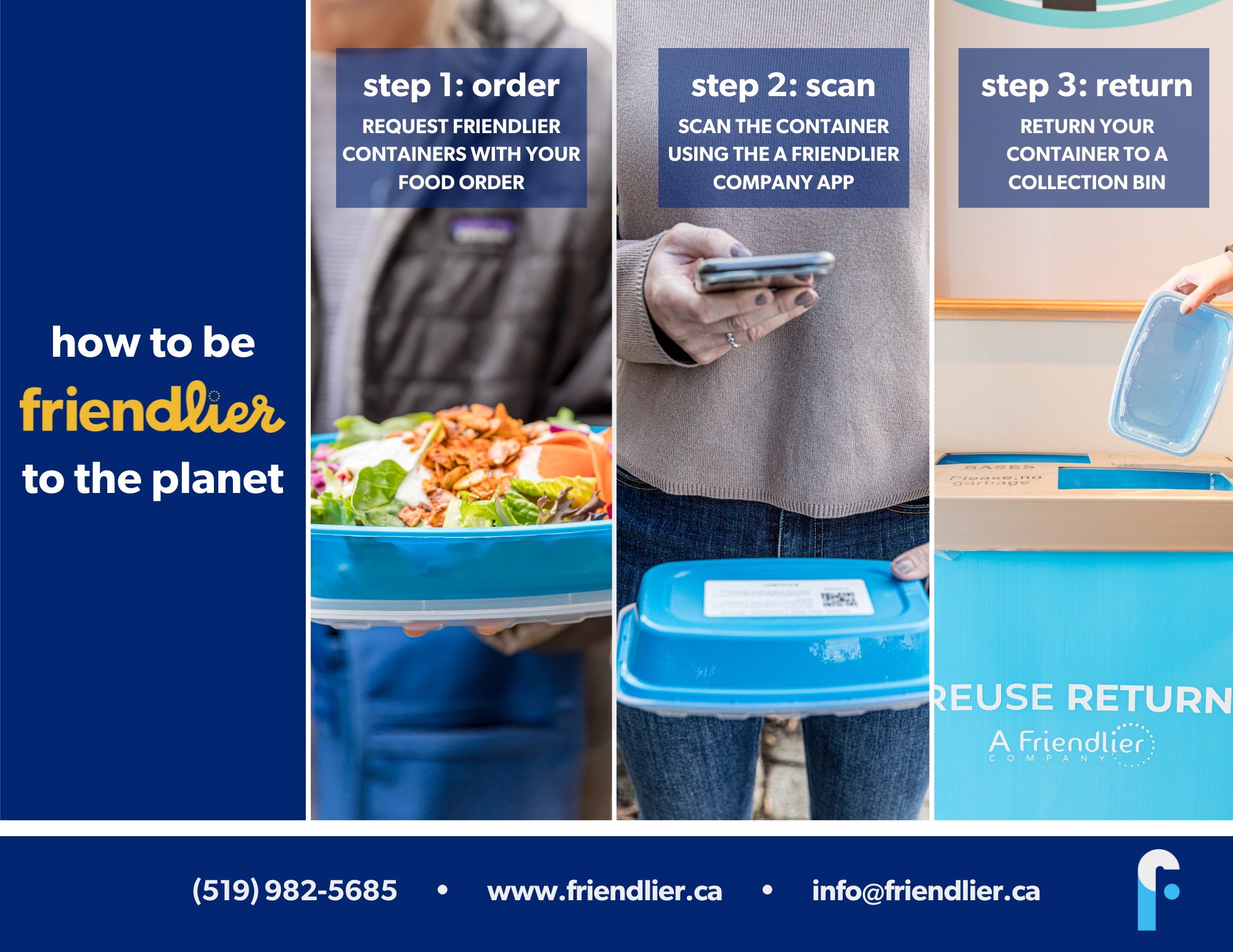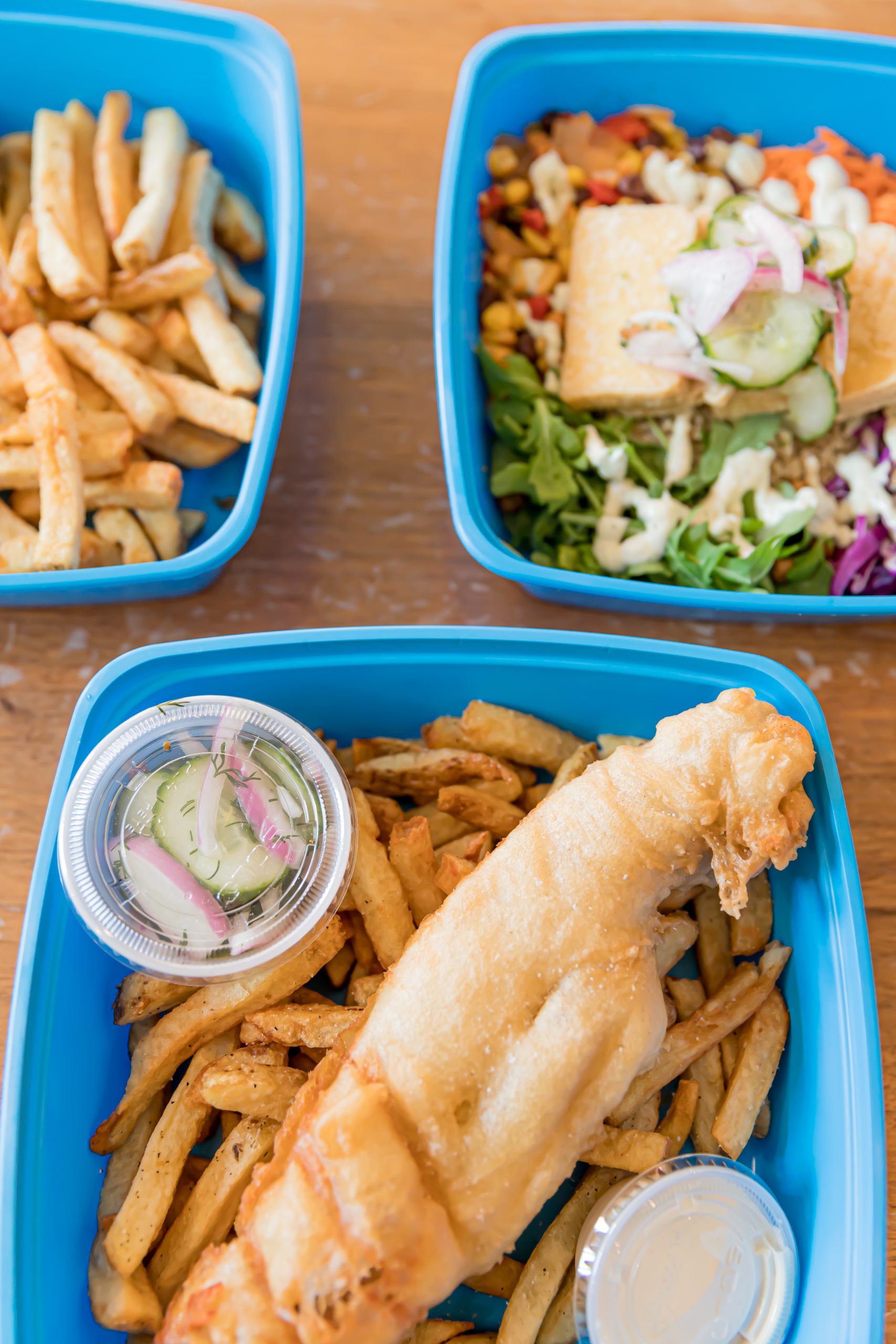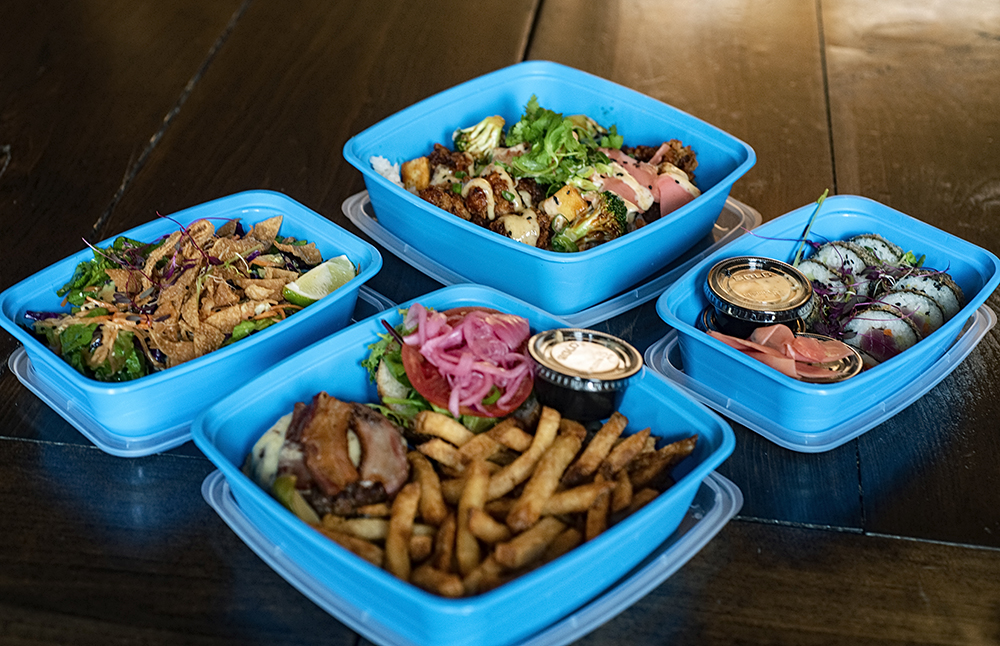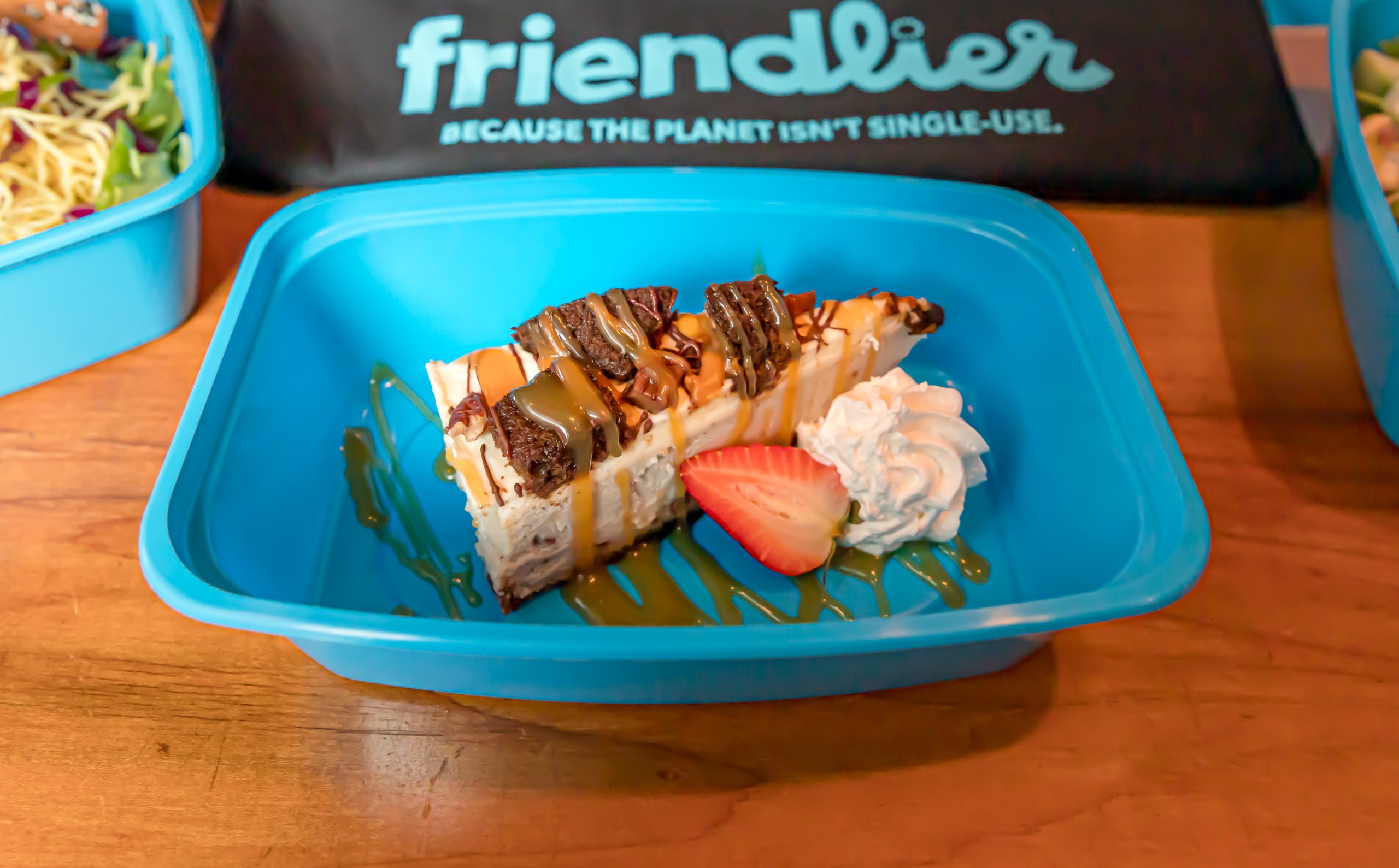Vol. 1, No. 2 (December 2023)
Friendlier: Growth in Re-Use
Richard S. Bloomfield
All figures in Canadian dollars unless otherwise noted.
In summer 2022, Shivansh Skuta reviewed the seed funding valuation of the reusable food container company, A Friendlier Company Inc. (Friendlier), presented by co-founders Kayli Dale and Jacquie Hutchings. Skuta was a seasoned investor in young start-up companies and had offered to review the request for seed funding[1] before Friendlier sought out other investors. Skuta was one of the initial investors in Friendlier and believed in its circular economy[2] and sustainability-focused business model, but they needed to ensure that the ask for other investors was feasible based on the company’s projected financial position.
History
Friendlier
Friendlier was established in 2019 by CEO Kayli Dale and COO Jacquie Hutchings. Friendlier was a reverse logistics company for reusable, returnable packaging that aimed to eliminate single-use plastic takeout packaging entirely. Friendlier’s three-step process made it easy for restaurants to be more eco-conscious. First, the restaurant customer could receive their order in a waste-free container. Second, the customer could scan the container’s unique QR code via their smartphone or enter the code on the Friendlier website. Third, the customer could drop off the container in a return bin at any one of Friendlier’s participating locations. Finally, within one to two weeks of drop off, the customer could claim their deposit return by requesting an e-transfer through the Friendlier platform.[3] See Exhibit 1 – The Friendlier Process for an illustration of this process.
Restaurants could begin their partnership with Friendlier by ordering a case of their reusable containers offered in a variety of sizes to accommodate differing demands. Friendlier provided restaurants with a no-commitment policy, allowing them to opt out at any time. Restaurants could reorder to replenish inventory in the same way they typically did with single-use products. After purchasing the containers, restaurants could begin to serve their meals using this premium, multi-use alternative. The collection, sanitation, and deposit returns were completed by the Friendlier team, allowing restaurants to focus on their typical operations. Since incorporation, Friendlier had partnered with over 100 businesses to bring more sustainable practices across Southwestern Ontario. These businesses were located in Guelph, Waterloo, Hamilton, London, Stratford, St. Marys, Ottawa, Collingwood, and the Greater Toronto Area (GTA). Friendlier had been recognized as Canada’s fastest-growing reuse company and received funding of $100,000 from Sustainable Development Technology Canada.
Kayli Dale and Jacquie Hutchings
Kayli Dale graduated from the University of Waterloo, located in Southwestern Ontario, with a Bachelor of Science in chemical engineering in 2020. Dale was highly involved in activities and societies during her undergrad. She was the Engineering Society director, an Orientation Day Leader, and the Waterloo Engineering Endowment Foundation (WEEF) class representative. Alongside these extra-curricular initiatives, Dale also worked as a co-op student for multiple companies. As a metallurgical fuels co-op student and a plant engineering co-op student, Dale was disheartened to see that sustainable corporate practices were not a priority to overall business operations.
Jacquie Hutchings also graduated from the University of Waterloo with a Bachelor of Science in applied science in 2020. Similar to Dale, Hutchings was a WEEF class representative and a part of the Engineering Fall Semi-Formal directorship team. In her third year of studies, Hutchings joined Dale on an exchange to Sweden, attending Lund University to study chemical engineering. This study term abroad provided the inseparable duo with the opportunity to learn from a new cultural perspective that emphasized minimalism and environmental sustainability. In comparing the North American practices with Sweden’s, Dale and Hutchings indicated that they came back to Canada with a new passion: To live more purposeful lives and find ways to be friendlier to the planet.
Dale and Hutchings knew that when they graduated, addressing the climate crisis would be their first priority and that they wanted environmental sustainability to be at the forefront of their careers. Although they did not study business during their undergraduate degrees, they wanted to start their own company that aligned with [their] values. Although they did not study business during their undergraduate degrees, they wanted to start their own company that aligned with these values. Their chemical engineering experience was valuable in creating the logistics systems required for Friendlier, and Dale created the first version of their smartphone app while they were still studying at the University of Waterloo. They originally prepared to launch a reusable cup system for events in the summer of 2020, but the COVID-19 pandemic required them to pivot toward the suddenly booming takeout packaging market. See Exhibit 2 – Examples of Friendlier Containers for examples of their most popular takeout packaging. The founders were able to launch with their first restaurant partner in Guelph late in 2020 and have since expanded across Ontario, including partnerships with SkipTheDishes and, more recently, Loblaws. Dale and Hutchings believed that their early success was rooted in Friendlier’s vision and values. Friendlier continued to strive toward becoming a household name in the reusable packaging industry by substituting a single-use linear process with a circular process.
Industry and Competitors
Reusable Packaging Industry
The United Nations Environment Programme reported that nearly 7 billion of the 9.2 billion tonnes of plastic produced from 1950 to 2017 ended up in landfills or was dumped into rivers, lakes, and oceans.[4] As people became aware of the environmental impact dumping plastic had, there was a growing demand for sustainable packaging alternatives. As such, the global sustainable packaging market was valued at $164 billion in 2020 and was expected to have a compound annual growth rate of 6.6% from 2022 to 2031.[5] Over the past five years, there had been a 71% rise in consumer searches for sustainable goods, and this rate was steadily increasing.[6] However, consumers needed sustainability to be affordable if they were to consider it a viable option. Although Canadians acknowledged that sustainable alternatives were more desirable over single-use plastics, the willingness to pay for them was limited. A Canada-wide survey revealed that 93.7% of respondents were personally motivated to reduce consumption of single-use plastic food packaging but less willing to pay a premium for sustainable alternatives.[7]
The Government of Canada had plans to ban single-use plastics and ensure the companies that manufacture and sell plastic products adhere to new standards.[8] The new regulations had been one of the driving forces behind the renewed interest in sustainable packaging companies. Two such companies are Dare Foods and Pactiv. Dare Foods was a family-owned business based in Canada. During its long 132 years, Dare Foods had developed strong relationships within the industry and a loyal customer base.[9] Meanwhile, Pactiv was a manufacturer and distributor of food packaging and food service products across North America and was owned by a parent company worth $1.72 billion: Pactiv Evergreen. Pactiv had many manufacturing sites and distribution warehouses of it own, which gave it significant leverage over its competition. Although there were many other food packaging companies that offered similar services, Dale and Hutchings considered Dare Foods and Pactiv to be their main competitors in the industry.
Customers
Rather than selling directly to independent restaurants, Friendlier sold their products to distribution companies that then sold to restaurants. By using packaging distributors, Friendlier was able to simultaneously save time and resources and also reach a greater number of restaurants. Additionally, Dale and Hutchings knew that it was important to have their product used more frequently, so they turned to contract food service companies, which included many corporate and university cafeterias, where people often throw out disposable containers immediately after use.
In general, Dale and Hutchings found that most food service businesses had much higher demand during December and, therefore, increased their orders from Friendlier in November. To prepare for this surge in demand each year, the founders anticipated needing an extra $200,000 of cash to acquire inventory in October, and they were unsure if their current line of credit limit of $300,000 would be sufficient.
Financial Request
Both founders were aware that global corporations were making large commitments to move away from single-use packaging[10] and that meant they would need the support of companies like Friendlier to meet these commitments. Given the prevailing trends, and the founders’ belief that they had completed a proof of concept with large partners like Loblaws, they projected their sales and deferred revenue to grow by 700% in 2022 and a further 250% in 2023. See the following exhibits for previous financial statements:
- Exhibit 3 – A Friendlier Company Inc. Statements of Earnings
- Exhibit 4 – A Friendlier Company Inc. Statements of Retained Earnings
- Exhibit 5 – A Friendlier Company Inc. Statements of Financial Position
- Exhibit 6 – A Friendlier Company Inc. Statement of Cash Flows
- Exhibit 7 – Ratio Analysis
To support rapid growth across all of Ontario, Dale and Hutchings expected that they would need to rent and equip two additional cleaning facilities, as well as increase their capacity at their Guelph and Ottawa locations. Total rent for all locations was expected to be $220,000 annually for the next three years. They expected the cost of all the equipment needed would be close to $690,000 and would have a useful life of 10 years. In addition, they would need to purchase three delivery trucks to support picking up and dropping off containers to their distributors. The trucks would cost $60,000 each and were expected to last five years. All new assets would have no residual value and would be depreciated using the straight-line method. In addition to the assets required to support their growth, the founders would have to hire five additional full-time staff in 2022, doubling their wages, salaries, and benefits expense from the previous year. They expected wages, salaries, and benefits to be the same percentage of sales in fiscal 2023 as fiscal 2022.
The founders admitted that managing their supplier and customer accounts would be challenging during such a high growth phase of their business. However, Dale and Hutchings believed that they could expect their accounts receivable days to only increase by 10 days over fiscal 2021 next year. They also predicted that their strong relationship with the container manufacturer they worked with would allow them to extend their accounts payable days by 15 next year and a further 10 days in 2023. To support the growth projected, a significant increase in inventory would be required. Therefore, this was one of the reasons Friendlier needed to raise further funding for the business. The projected days of inventory would remain the same in fiscal 2022 and decrease to 365 days in fiscal 2023.
The founders expected that most other operating expenses, excluding cost of goods sold,[11] would likely increase at the same rate as sales growth, but they also knew there were at least some expenses that did not necessarily relate to sales growth. For example, Dale and Hutchings planned to spend $80,000 and $110,000 on advertising and promotion, and they knew that their insurance policy would increase to $3,000 and $5,000 in 2022 and 2023, respectively.
Dale and Hutchings both knew that the next stage of the business would require significant growth across all areas of their business and would require a large amount of capital to fund appropriately. Although the founders wanted to preserve equity ownership for themselves, they knew that it would not be possible to fund this growth with debt, given the cash flow implications this would have. The founders were hoping to raise between $3,000,000 and $5,000,000 in equity funding during their upcoming seed round but were not sure if this would be sufficient to support their growth.[12] Their existing long-term debts would remain the same as the previous year, and they expected the total bank charges and interest expense for the business to be the same dollar amount as fiscal 2021.
Decision
In reviewing the 2022 Friendlier seed funding evaluation, Skuta was optimistic about the future of the company but knew they needed to better understand the capital required to determine whether the investment was viable. The owners believed strongly that businesses in the future would have to be built on a foundation of environmental sustainability, rather than simply “adding on” sustainable projects in an attempt to make consumers feel better about their choices. While Skuta agreed with the owners’ mission, they wanted to fully understand the capital Friendlier would require and needed to conduct a thorough review of the past financial performance of the company by analyzing the statement of cash flows and ratios as well as projecting two years of financial statements, including any extra cash risks predicted. Determined to gain a better understanding of the capital required, Skuta rolled up their sleeves and began their detailed financial review.
Exhibits
Exhibit 1 – The Friendlier Process

Exhibit 2 –Examples of Friendlier Containers



Exhibit 3 – A Friendlier Company Inc. Statements of Earnings (for the Years Ending December 31)
|
Statement of Earnings Accounts and Subtotals |
2021 |
2020 |
|
Revenue |
|
|
|
Net Sales |
$79,206 |
$8,415 |
|
Cost of Goods Sold |
|
|
|
Beginning Inventory |
8,715 |
– |
|
Purchases |
128,340 |
10,995 |
|
Ending Inventory |
80,818 |
8,715 |
|
Cost of Goods Sold |
56,237 |
2,280 |
|
Gross Profit |
$22,970 |
$6,134 |
|
Expenses |
|
|
|
Advertising and Promotion |
$24,817 |
$2,673 |
|
Depreciation |
4,168 |
– |
|
Bank Charges and Interest[13] |
377 |
113 |
|
General and Administration |
12,011 |
1,044 |
|
Insurance |
1,754 |
295 |
|
Meals and Entertainment |
806 |
267 |
|
Rent |
68,713 |
1,738 |
|
Professional Fees |
5,097 |
896 |
|
Subcontractors |
7,294 |
– |
|
Travel |
1,433 |
112 |
|
Wages, Salaries, and Benefits[14] |
228,224 |
19,213 |
|
Total Expenses |
$354,693 |
$26,350 |
|
Net Loss From Operations |
$(331,723) |
$(20,215) |
|
Other Revenue and Expenses: |
|
|
|
Grants |
$149,613 |
$17,225 |
|
Net Loss |
$(182,110) |
$(2,990) |
Source: Based on financial data supplied by A Friendlier Company Inc.
Exhibit 4 – A Friendlier Company Inc. Statements of Retained Earnings (for the Years Ending December 31)
|
Statement of Retained Earnings Accounts |
2021 |
2020 |
|
Beginning retained earnings |
$(2,990) |
– |
|
Add: Net loss |
$(182,110) |
$(2,990) |
|
Less: Dividends |
– |
– |
|
Ending Retained Earnings |
$(185,101) |
$(2,990) |
Source: Based on financial data supplied by A Friendlier Company Inc.
Exhibit 5 – A Friendlier Company Inc. Statements of Financial Position (as at December 31)
ASSETS
|
Statement of Financial Position Accounts and Subtotals |
|
2021 |
2020 |
|
Current Assets: |
|
|
|
|
Cash |
|
$429,856 |
$34,637 |
|
Accounts receivable |
|
20,401 |
4,155 |
|
Inventory |
|
80,818 |
8,717 |
|
Income tax recoverable[15] |
|
55,172 |
– |
|
Total current assets |
|
$586,247 |
$47,509 |
|
Fixed assets: |
|
|
|
|
Furniture and equipment[16] |
$12,350 |
|
|
|
Less: Accumulated depreciation |
$1,235 |
$11,115 |
|
|
Vehicle[17] |
$19,551 |
|
– |
|
Less: Accumulated depreciation |
$2,933 |
$16,618 |
– |
|
Total fixed assets |
|
$27,733 |
– |
|
Total assets |
|
$613,980 |
$47,509 |
LIABILITIES AND EQUITY
|
Statement of Financial Position Accounts and Subtotals |
|
|
|
|
Current Liabilities |
|
|
|
|
Accounts payable and accrued liabilities |
|
$5,438 |
$1,463 |
|
Deferred revenue[18] |
|
70,617 |
– |
|
Due to shareholders |
|
10,013 |
10,013 |
|
Total current liabilities |
|
$86,068 |
$11,476 |
|
Long-term debt |
|
712,990 |
39,000 |
|
Total liabilities |
|
$799,058 |
$50,476 |
|
Shareholders’ equity |
|
|
|
|
Capital stock |
|
23 |
23 |
|
Retained earnings |
|
(185,101) |
(2,990) |
|
Total equity |
|
(185,078) |
(2,967) |
|
Total Liabilities and Equity |
|
$613,980 |
$47,509 |
Source: Based on financial data supplied by A Friendlier Company Inc.
Exhibit 6 – A Friendlier Company Inc. Statement of Cash Flows (for the Years Ending December 31)
|
Statement of Cash Flow Accounts and Subtotals |
2021 |
|
OPERATIONS |
|
|
Net Loss |
$(182,110) |
|
Adjustments to Cash Basis: |
|
|
Depreciation |
4,168 |
|
Accounts Receivable |
(16,246) |
|
Inventory |
(72,102) |
|
Income Tax Recoverable |
(55,172) |
|
Accounts Payable and Accrued Liabilities |
3,975 |
|
Deferred Revenue |
70,617 |
|
Net Cash Flow from Operations |
$(246,870) |
|
Financing |
|
|
Due to Shareholders |
$ – |
|
Long-Term Debt |
673,990 |
|
Capital Stock |
– |
|
Net Cash Flow from Financing |
$673,990 |
|
Investing |
|
|
Furniture and Equipment |
$(12,350) |
|
Vehicle |
(19,551) |
|
Net Cash Flow from Investing |
$(31,901) |
|
Beginning Cash |
$34,637 |
|
Total Cash Flow |
395,219 |
|
Ending Cash |
$429,856 |
Source: Based on financial data supplied by A Friendlier Company Inc.
Exhibit 7 – Ratio Analysis
|
Ratio Analysis |
2021 |
2020 |
|
PROFITABILITY |
|
|
|
Revenue |
100.0% |
100.0% |
|
Cost of Sales |
71.0% |
27.1% |
|
Gross Profit |
29.0% |
72.9% |
|
Expenses |
|
|
|
Advertising and Promotion |
31.3% |
31.8% |
|
Depreciation |
5.3% |
– |
|
Bank Charges and Interest |
0.5% |
1.3% |
|
General and Administration |
15.2% |
12.4% |
|
Insurance |
2.2% |
3.5% |
|
Meals and Entertainment |
1.0% |
3.2% |
|
Rent |
86.8% |
20.7% |
|
Professional Fees |
6.4% |
10.6% |
|
Subcontractors |
9.2% |
– |
|
Travel |
1.8% |
1.3% |
|
Wages, Salaries, and Benefits |
288.1% |
228.3% |
|
Total Expenses |
447.8% |
313.1% |
|
Net Loss from Operations |
-418.8% |
-240.2% |
|
Other Revenue and Expenses: |
|
|
|
Grants |
188.9% |
204.7% |
|
Net loss |
-229.9% |
-35.5% |
|
LIQUIDITY |
|
|
|
Current Ratio |
6.8x |
4.1x |
|
Acid Test |
5.2x |
3.4x |
|
Working Capital |
$500,180 |
$36,033 |
|
EFFICIENCY |
|
|
|
Age of Receivables (Days) |
94 |
180 |
|
Age of Payables (Days) |
15 |
49 |
|
Age of Inventory (Days) |
524 |
1,395 |
|
STABILITY |
|
|
|
Net Worth/Total Assets |
N/A |
N/A |
|
Interest Coverage |
N/A |
N/A |
|
GROWTH |
|
|
|
Revenue Growth |
841% |
– |
|
Profit Growth |
N/A |
– |
|
Asset Growth |
1,192% |
– |
Source: Based on financial data supplied by A Friendlier Company Inc.
Image Descriptions
Exhibit 1
A promotional graphic with four vertical panels.
- Panel 1 reads “How to be friendlier to the planet.”
- Panel 2 reads “Step 1: Order – request friendlier containers with your food order” over a photo of a salad in a takeout container
- Panel 3 reads “Step 2: Scan – scan the container using the A Friendlier Company app” over a photo of a person scanning a QR code on the bottom of the takeout container with their phone.
- Panel 4 reads “Step 3: Return – return your container to a collection bin,” over a photo of a hand dropping a clean container into a collection box labelled “reuse return.”
Below the four panels is a horizontal box with contact information: (519) 982-5685; www.friendlier.ca; info@friendlier.ca, and the Friendlier logo.
Exhibit 2
Three photos of blue Friendlier takeout food boxes in different sizes and widths, containing different types of foods, including French fries, burgers, salad bowls, fish and chips, and cheesecake.
References
Businesswire. (2022, June 07). Global green packaging market forecast report 2022-2031: Recycled content packaging held nearly 60% of total green packaging market—ResearchAndMarkets.com. https://www.businesswire.com/news/home/20220607005747/en/Global-Green-Packaging-Market-Forecast-Report-2022-2031-Recycled-Content-Packaging-Held-Nearly-60-of-Total-Green-Packaging-Mar-ket—ResearchAndMarkets.com
Charlebois, S., McGuinty, E., Music, J. & Walker, T.R. (2021). Single-use plastic packaging in the Canadian food industry: Consumer behaviour and perceptions. Humanities and Social Sciences Communications, 8(1). https://www.nature.com/articles/s41599-021-00747-4
Climate Action. (2021, May 18). WWF: Huge rise in demand for sustainable goods during pandemic [Press release]. https://www.climateaction.org/news/wwf-huge-rise-in-demand-for-sustainable-goods-during-pandemic
Dare Foods. (n.d.). Our story. https://www.darefoods.com/our-story/
Starbucks. (2022, March 15). Starbucks affirms commitment to a planet positive future through innovation and learnings from store partners [Press release]. https://stories.starbucks.com/press/2022/starbucks-affirms-commitment-to-a-planet-positive-future-through-innova-tion-and-learnings-from-store-partners/
Prime Minister’s Office (2019, June 10). Canada to ban harmful single-use plastics and hold companies responsible for plastic waste [Press release]. Government of Canada. https://www.pm.gc.ca/en/news/news-releases/2019/06/10/canada-ban-harmful-single-use-plastics-and-hold-companies-responsible
UN Environment Programme. (n.d.). Plastic pollution. https://www.unep.org/plastic-pollution
Download a PDF copy of this case [PDF].
Read the Instructor’s Manual Abstract for this case.
How to cite this case: Bloomfield, R.S. (2023). Friendlier: Growth in re-use. Open Access Teaching Case Journal, 1(2). https://doi.org/10.58067/kz6e-k930
The Open Access Teaching Case Journal is a peer-reviewed, free to use, free to publish, open educational resource (OER) published with the support of the Conestoga College School of Business and the Case Research Development Program and is aligned with the school’s UN PRME objectives. Visit the OATCJ website [new tab] to learn more about how to submit a case or become a reviewer.

- Seed funding was initial capital invested in a start-up company in exchange for equity or an equity stake upon conversion. ↵
- A circular economy was a model of production and consumption that attempts to share, lease, reuse, repair, refurbish, or recycle existing materials and products as long as possible to minimize the use of resources. ↵
- See the Friendlier Company Inc. website. ↵
- UN Environment Programme, n.d. ↵
- Businesswire, 2022. ↵
- Climate Action, 2021. ↵
- Charlebois et al., 2021. ↵
- Prime Minister’s Office, 2019. ↵
- Dare Foods, n.d. ↵
- Starbucks, 2022. ↵
- Dale and Hutchings expected that with economies of scale, their cost of goods sold would drop to 60% of sales in 2022 and 45% in 2023. ↵
- Dale and Hutchings assumed $0 in cash for their upcoming projections. ↵
- No interest was charged on the long-term note; therefore, this expense represents only bank charges. ↵
- Approximately 50% of these costs were for fixed salaries. ↵
- Income tax recoverable was expected to grow by 50% in each of the next two years. ↵
- Useful life of 10 years. ↵
- Useful life of 5 years purchased part way through the fiscal year. ↵
- Deferred revenue represented deposits owed to customers who returned their Friendlier containers. ↵

